The hero is he who is immovably centred
Ralph Waldo Emerson
If I had to explain Apotheon to someone who doesn’t play video games, I’d say this: “imagine the figures of ancient Greek vase art, come to life…” This pithy description seems to best fit the game’s concept, and the childlike sense of delight it manages to recreate in the eye of the beholder.
Apotheon is, of course, something a bit more specific: it’s a video game, produced in the 2D side-scroller metroidvania style, using ancient Greek myth and art as its setting. And the Greek vase idea is more than just a gimmick: Apotheon also delivers compelling gameplay with its puppet-like, yet fluid combat mechanics, and its brilliant and imaginative level design.
At first sight, Apotheon (from the Greek apo + theon: ‘away from the gods’, or ‘godless’) can be seen as one of the many games that reference Greek mythology in their story and gameplay. As such, the game’s backstory is not particularly original. The player is Nikandreos, a prototypical hero of (neo-) Greek mythology, who must save humanity from the wrath of the gods. With the aid of Zeus’ wife Hera, Nikandreos’ ascent (and descent) to the realm of the gods, his trials and tribulations worthy of a Theseus or Herakles, ultimately bring him to confront Zeus, along with the many deities and minions of Greek mythology.
A typical promethean Hero’s Journey, straight from the culture that created so many of its archetypes. So is Apotheon offering us the same old mythology wine, with the same new video game bottles?
Perhaps, but there is much more to Apotheon than its backstory.
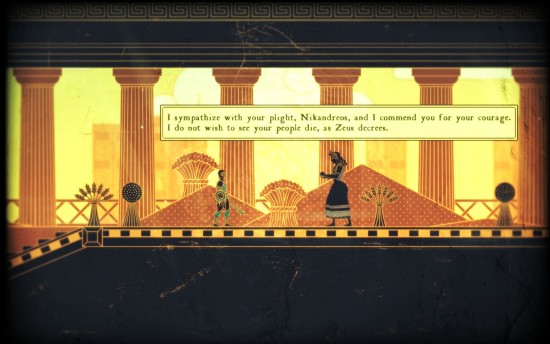
Firstly, Apotheon keeps a tight leash on the tropes of classical Greek myth. The game successfully blends classical culture with contemporary interactive entertainment, staying true to the constraints of both forms. In this way, Apotheon follows in the footsteps of some of the recent indie titles (The Banner Saga and Never Alone come to mind), paying creative tribute to humanity’s ancestral folk wisdom and lore, in the format of a video game.
Furthermore, the way Apotheon uses Greek myth, I would argue, tells us something about the nature of video games. The action hero of the video game resembles, in many ways, the action hero of Greek mythology: typically masculine, bereft of psychology, projected into a universe of vivid happenings, quasi-immortal, yet in a perpetual state of existential threat, fighting for redemption. Perched between life and death, the mythical hero exists as an “immovable centre”, a bridge between immortals and mortals, story and audience, game and player. And in today’s world, machine and man.
In this article, I will examine how Apotheon‘s tribute to classical Greek art and mythology enhances our understanding of video games. The peculiar blending of archaic and modern cultural forms, as found in Apotheon, suggests a new line of questioning: what happens to humanity’s ancestral memory, or mythological past, when it morphs into a play space? Can the protean visions of Greek mythology throw some light, across the ages, on the “soul” of today’s gamers?
If you, Nikandreos, wish to rescue humanity, what must you become? What payments will the gods require of you for your heroic deeds?
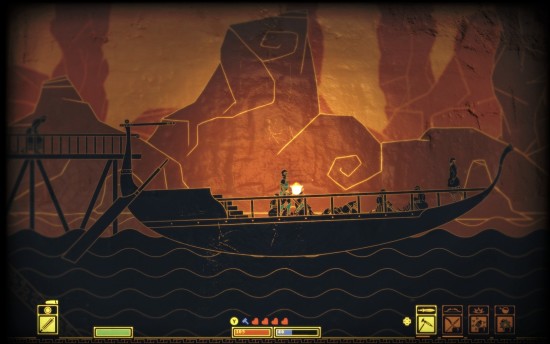
The Gods of Gameplay
Though it would be tempting to look underneath the hood of Apotheon to understand why (for the most part) it works so well, I will leave this task to the many insightful game critics who have reviewed the title. Because of the nature of my argument, I will eschew video game criticism per se, and shift my focus instead on the overall aesthetic of Apotheon, and its wider implications. For in my opinion, Apotheon has the unique merit of integrating art style and gameplay, in an experience that reaches beyond the limits of the video game form, and yet remains a fully-realized video game.
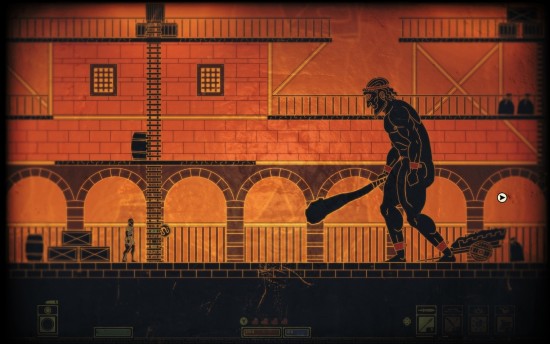
The best way to examine a game’s ‘experience design’ (to use a fashionable expression), is to look at it from the developer’s perspective. Apotheon, like countless video games, is built on the architecture of a predecessor. Developer Alientrap, originally a Saskatoon/Toronto duo, released its first commercially successful title, Capsized, in 2011. Both Capsized and Apotheon are 2D side-scrollers, and audiences who have followed the studio can attest to the liberal gameplay borrowings from the former to the latter title. Capsized proposed an action-packed side-scrolling space adventure. Apotheon does the same, and refines the gameplay and the pacing of the earlier title, replacing space weapons with “authentic” ancient Greek weaponry and setting.
Apotheon’s art concept is also indirectly derived of Alientrap’s previous title: the Greek theme emerged from the introduction of quasi-mythological baddies for a cyberpunk sequel to Capsized. Recognizing the potential of the Greek vase figure in a 2D side-scrolling format – along with the rich repository of potential game characters contained in Greek mythology – Alientrap decided to produce an exclusively Greek-themed title, built around the Greek action hero.
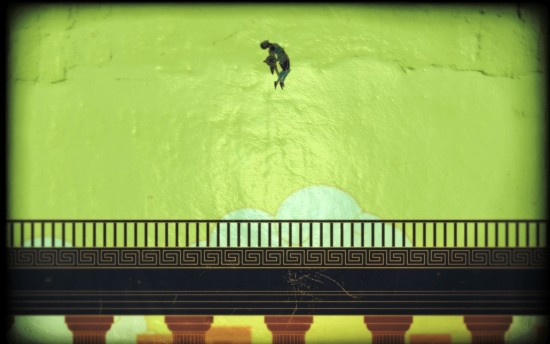
Yet, despite the filiation between the two titles, Apotheon does not feel like the same old action game with a flashy new paint coating. There is, beyond the obvious criticisms of the game (clichéd story, conflicting character control schemes) a certain finesse with the whole package. The sense of delight attested by many players in discovering the game, has to do with the feel of the experience, an integrated aesthetic that operates on many simultaneous levels. The initial attraction of the Greek theme and art style pulls the player into the experience. The player quickly discovers that the game is action focussed, and is thrilled to enjoin his hero-puppet into epic combat with the gods, demigods and other creatures of Greek mythology, using authentic period weapons. Finally, the player endeavours to explore the distinct realms of each deity of the Greek pantheon, and take up each unique challenge as it presents itself, with plenty of easter eggs for the hungry and spelunkious.
In a nutshell, if I were to reverse-engineer Alientrap’s player experience goals for Apotheon, I would stop at the three following game aesthetic layers:
- Art style
- World/level design
- Combat gameplay
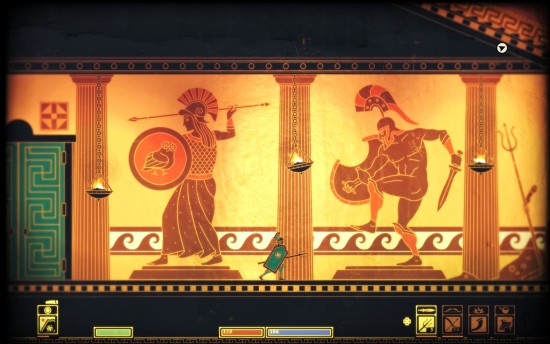
Game ≠ Story
I’ve omitted ‘story’ from these major categories, as I believe the game’s backstory and mythological tidbits remain a contextual layer, the gift wrapping around the gift itself. This is key, as I believe Alientrap have delivered us a full-motion aesthetic tribute to Greek myth, not just an interactive story set in Ancient Greece. To be strict in our assessment of the game’s purpose, our sights must remain on the essential elements of the game’s aesthetic.
As video games are experienced both as a whole (une œuvre, in French) and in their moment-to-moment gameplay, they must be built from the ground up, from the inner core to the outer layer, with the big picture always in view. Fundamentally, all games begin with gameplay. If Alientrap wished to recreate Greek mythology in gameplay, this meant the moment-to-moment action and the overall progression experienced by the player had to work as a video game and as a Greek art form. I won’t review all the elements that were put in place for the game’s specific formula – art design, sound design, music, lighting effects, character animations, control schemes, progression system, enemy variety and combat balancing, boss fights, level design, open world architecture, etc. – but suffice it to say that taken together, these game features reference two core aesthetic concepts: feel, and atmosphere. And if Alientrap has built a bridge between archaic culture and modern entertainment, it is precisely by fusing the kinaesthetic art of the video game with the unique atmosphere of Greek myth.
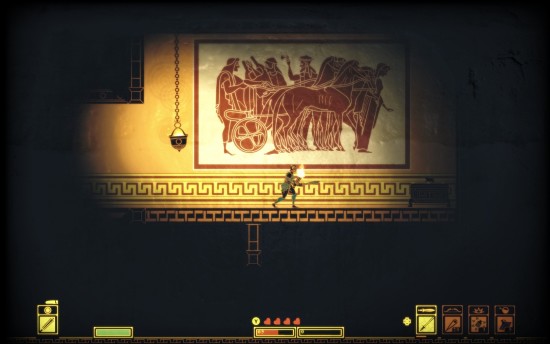
A Window into Mythology
As already mentioned, Apotheon is not the first game to dip into the glorious primordial pool of Greek mythology – far from it. However, it does have the distinctive trait of using a visual art style from antiquity as the springboard for its art direction and gameplay. The game takes the nifty idea of bringing the mythological (and quasi-historical) figures of 4th to 6th century BC Greek black-figure pottery art to life, to offer a fully-rendered mythological play space.
In doing this, Apotheon, creates a sensorial window through which players can ‘partake’ in myth. The Greek virtue of Beauty is present in every detail of the game – the way movement is rendered, the stunning visuals, and the evocative musical score. Furthermore, Apotheon’s dual focus on combat and exploration presents myth in an aspect that can’t be replicated in books: movement, or kinesis. In this vein, the game’s Greek hero is instantly recognizable, ever so disposed for epic combat and swift-footed, far-leaping peregrinations into the realms of the gods.
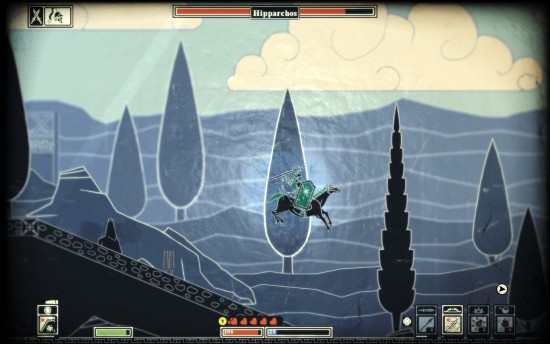
Taken together, art and gameplay work kinaesthetically on the player, mesmerized by his own moment-to-moment action hero puppeteering, and by an enfolding mythical world that is at once intimate and strange. Finally, these interlocking aesthetic parts are held together in the game’s architecture, its narrative and world design. Thus, as a ‘total package’, Apotheon is able to recreate, in my view, the special ‘atmosphere’ of Greek mythology.
Now, you might object by saying that every game has an ‘atmosphere’. And so what makes Apotheon’s special, beyond the fact that it references Greek art with some level of fidelity?
The answer lies in the nature of Greek myth itself, and the way it is being ‘revived’ in Apotheon.
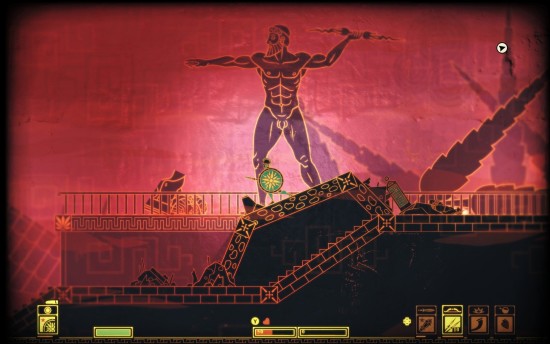
The Atmosphere of Greek Myth
Let us clarify what we mean with ‘Greek Mythology’. Wikipedia defines Greek Mythology as:
“[…]the body of myths and teachings that belong to the ancient Greeks, concerning their gods and heroes, the nature of the world, and the origins and significance of their own cult and ritual practices. It was a part of the religion in ancient Greece. Modern scholars refer to and study the myths in an attempt to throw light on the religious and political institutions of Ancient Greece and its civilization, and to gain understanding of the nature of myth-making itself.”
When I point to ‘the special atmosphere of Greek myth’, I am referring to the content and scope of Greek archaic culture, as symbolized in Greek art and literature. Two thousand years after its full flourishing, Greek mythology continues to fascinate us with the sheer scope of the phenomena, human, natural and supernatural, it captures in its stories and settings. More poignantly, once upon a time (during the Enlightenment) it was fashionable to assert that Greek mythology was the ‘pure product of human imagination’. Yet, we have come full circle. No one today would be so brashly dismissive of the ‘truths’ contained in the mythical image and imagination.
As the rationalist view of mythology is waning, there is, in its wake, a rekindling of affinities between today’s fans of Greek myth, and ancient mythographers. As French historian Paul Veyne discusses in his book Les Grecs ont ils cru en leurs mythes? (Transl.: ‘Did the Greeks believe their own myths?’) ancient writers and critics held two simultaneously contradictory views about mythology: one the one hand, they felt that the details of Greek myth were mostly wrong, on the other hand, they believed that myths were obscurely historical, and therefore on some level, true. To put it simply: ancient commentators of Greek myth held that if there was no reason to lie, then myth could not be, on a fundamental level, a lie. Even if it soaked in confabulation.
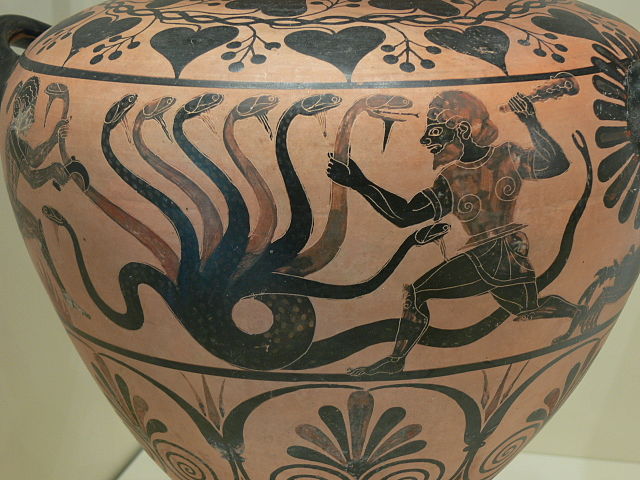
Today, every student and lover of mythology holds a similarly ambivalent, in not somewhat reverent, view of Greek mythology. In a nutshell, we believe that Greek myths contain, in the beauty of their stories and imagery, cryptic messages about the realities of human nature and the universe. Like religious scripture, there is no definitive literal interpretation of Greek myths, nor any way to separate historical phenomena from folk literature – even when one has stripped away the obviously fictional elements. This elemental confusion between original, factual and fictional, at the heart of Greek myth, is what gives it its unique atmosphere. Thus, our Greek mythology ‘sensory apparatus’ is reawakened whenever we contemplate the beauty of its original pictorial forms, as found in Greek archaic and classical art.
Video Games: Experience over Knowledge
Until the advent of modern archaeology, the transmission of Greek myth was largely carried out by mythographers, in the written accounts of mythology. This record in literature, philosophy and philology, vital as it remains today, has however introduced a bias into our assessment of mythology, namely, the bias of erudition. In this light, the mythographical record is at once exhaustive as it is narrow. Exhaustive, because the medium of writing excels in cataloguing the treasure troves of archaic folk wisdom, and analyzing its contents and genres. Narrow, because mythogaphers are often concerned with knowledge, over experience.
Video games as an art form, I believe, can bridge the gap between the preserved record of folk wisdom and the living spirit of myth. In their inversion of puppet theatre (the player/audience controls the in-game avatar – the ‘puppet’) video games that revive folk art can help actualize mythology. This is what I mean, when I point to Apotheon’s commingling of mythology and video game tropes, in the special ‘atmosphere’ of Greek myth. Theatre and film, in their dramatic reenactments of mythology, cannot propel us in media res, to take charge of the situation of the hero. They represent, while video games truly ‘reenact’ – even if at the limited level of pure action.
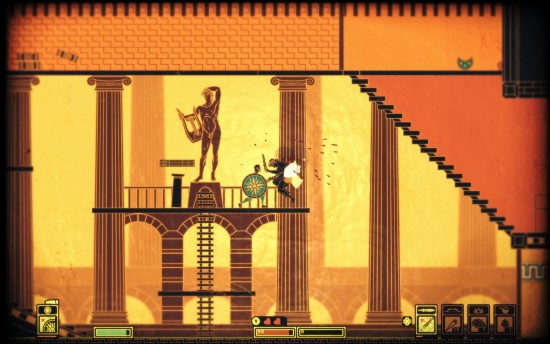
The Myth of Video Games
This brings us full circle, to the question of the hero. To complete my argument, I want to show how the ‘mythological atmosphere’ of Apotheon provides justification for the video game action hero’s lack of psychological depth. Or rather – because video games are an art form with cybernetics ‘roots’ – how myth can be a foil for the psychological reification (fancy term for ‘turning subjectivity into a manipulatable object’) of video game heroes.
We have already mentioned Apotheon’s lack of compelling character development. If you’ve read any of the reviews, you’ll note that this has been a common criticism of the game. One game reviewer, however, has pointed out that Apotheon’s simplistic narrative, rather than being impoverished, is rather fitting due to the subject matter. Instead of arguing for and against the game’s ‘clichéd story’ – if you’ve followed me so far, you know I don’t think this matters – I would instead like to make a case for the inevitability of shallow, or ‘non-subjective’ protagonists, in action-based video games. And in this way, show how Apotheon uses the myth of the Greek hero to its advantage.
Let us return to the opening quote of my article, by Emerson: ‘The hero is he who is immovably centred.’ Beyond evoking the essence of the Greek hero, what can this statement tell us about identity of the video game hero?
Two things, mostly. One refers to a structural feature of video games, the other to the choice of the ‘metroidvania’ video game genre by Apotheon developer Alientrap. In a Gamasutra article, author Christian Nutt identifies the factors that have let to the enduring appeal of the metroidvania genre. With its blend of action-hero gameplay, open world exploration and non-linear progression mechanics, the metroidvania genre has become a favourite pick for adventure-based games. As the name ‘metroidvania’ suggests, the genre was originally the result of converging design patterns and game tropes inside the 2D action-adventure category. And so, just as the Greek hero emerges in the act of storytelling, so does Apotheon’s action hero, Nikandreos, assert his identity by virtue of his epic tribulations in a metroidvania-style hostile world.
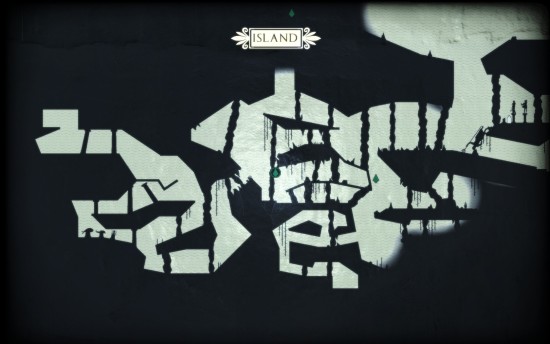
The other, more ‘structural’ aspect of heroic representation in games, is tied to the machine-player feedback loops that are inherent to video games. Video game gameplay is comprised of complex system of feedback loops (these differ by genre) between player and game. Yet a fundamental, if not commonplace feature of video games, is that the protagonist is perpetually at the centre of the action. Unlike narrative fiction, where the protagonist is at the heart of the story but may disappear occasionally from our attention for the sake of the plot, video games focus players’ attention on the moment-to-moment unravelling of the ‘story’ by keeping the actionable protagonist (or party of protagonists) on screen at all times.
Thus the ‘immovable centre’ of the action hero, is quite literally the centre stage of the video game image, as a locus of action. The metroidvania genre further enhances this focus on the protagonist with its centripetal structure – combining action-based, responsive and kinetic gameplay, with sprawling, multi-directional exploration. By virtue of this structure, the game’s ‘story’ (or progression) is no longer a linear text, leading to a fatal conclusion. Rather, it is a window into a mythical (open-)world, where the invisible ‘third wall’ of the mythological narrator is breached in favour direct manipulation of the action hero. In this way, the psychology of the action hero lies not in the plot, but in the game world itself, as it unfolds.
Thus, bound in the medium of video games, operating within the stylistic constraints of Ancient greek art and the metroidvania genre, Apotheon allows us to uniquely peek inside the head of the Greek hero. If Nikandreos is but an articulated puppet controlled by the player, it is the world and gameplay of Apotheon which brings him to life. In Apotheon, fans of ancient literature have, it seems, finally found a mythotope – or mythical space – to quench their thirst for the atmosphere of Greek mythology. The hero, ‘he who is immovably centred’, is the player – the player of every video game, freely choosing the fate the gods have set out for him, even as he fights them to the death in pitted battle, with clenched teeth.
Or so the myth goes.

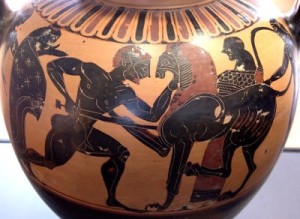
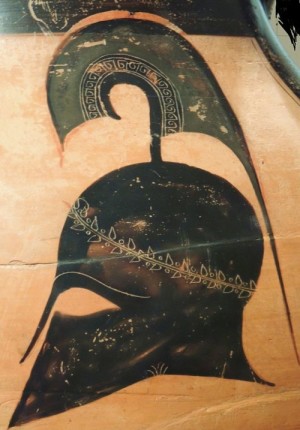
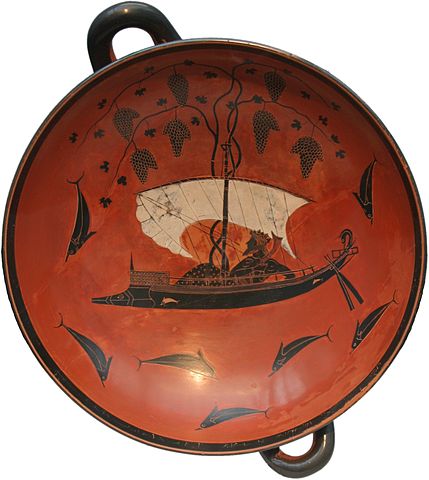
1 Comment